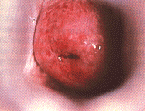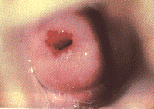| Increasing Fertility | Fertility Awareness | Cervical Dysplasia | Herbal Contraception | Herbal Abortion | Suggested Reading | Book Store | Search |
Observing the cervix, a little strange you might think. It is simple to do, and one of the most beneficial, educational things I have done in my search to manage my fertility. I think it makes an effective alternative to taking the Basal Body Temperature (BBT) each morning. In order for the BBT to be accurate, it must be taken at the same time each morning. My lifestyle is such that I don't wake at the same time each morning. I found observing the changes in my cervix gave me an effective method to observe the approach of ovulation, peak mucus, my os wide open with clear fertile mucus flowing out, and the disappearance of the fertile mucus and the subsequent closing of the os signaling the end of fertility for this cycle. One clear advantage to using a speculum over the BBT method, is that the BBT does not give you any warning at all of coming ovulation, only signals you when it is finished.
All you need is a plastic speculum, a mirror and a flashlight. It is a part of us that we rarely have the opportunity to view. It is the opening to the uterus, part of the birth canal, from where the menstrual blood flows, is truly fascinating. Nothing can compare to the wonder I felt, viewing my cervix for the first time in the comfort and privacy of my own home, opening a whole new avenue for managing my fertility and learning about myself.
To find your cervix, put two fingers inside your vagina and reach as far back as you can. Your cervix will feel firm maybe a little rubbery, like the end of your nose if you put your finger on the tip of your nose and push gently. There is also a depression in the center, this is the opening to the uterus, you should beable to feel this as well. Your cervix will be round and will definatly feel different than the walls of the vagina.
Charting is an invaluable tool, particularly when you are learning. Make one that suits your needs or print out the one I use. Charts kept every month give you something to look back at, compare to, and help you identify patterns. They can be as detailed as you wish them to be. They can be as simple as a calender with notes jotted down, or I keep my charts in a red binder (red for the menstrual blood) a page for every month. There are other charts available, mostly in the back of some of the books in the book section. Develop a little code to help you identify and specify the changes you are observing. Choose a symbol to use when you have sex, and when intercourse is protected, ie., with a condom make it a little different. For example, I use a little (*) asterisk to symbolize when I have sex, and put a circle around it when we use a condom. When charting use descriptive words, the more energy you put into your charts, the more they will help you down the road.
Observing your fertility signals can be a very effective form of birth control, but only if one is willing to devote the time it takes, which is really not a lot. But I cannot stress enough, the importance of when you are first learning fertility awareness, if you are sexually active, be extremely cautious. During the first three months always use condoms (you should use them anyway, if not in a monogamous relationship) because if you make a mistake, the result could very well be pregnancy. It takes a few months of charting to enable you to see the patterns begin to form, and discover what is normal for you.
When observing the cervix directly with a speculum it is very easy to note the changes in the cervical mucus. In fact it is hard not to notice. When books or fertility counselors talk of monitoring mucus, they are noting the cervical mucus as it reaches the opening of the vagina. It might take a few hours for this journey, or depending on the quantity of cervical fluid, and if there is very little, might be missed. When a speculum is used you are seeing the cervical mucus at its source. This is up to the minute information here!!
The next thing one might notice, besides the mucus or cervical fluid, is the opening of the cervix. Depending on where you are in your cycle, it may be obscured by a glob of mucus. This opening is called the os. This is the entrance to the uterus. The birth canal. From where the menstrual blood flows. It is utterly amazing that a baby can come out through this little tiny opening. No wonder labor hurts!!
Another cervical variation to check for is the location of the cervix/uterus within the vaginal canal. The cervix sits low in the vagina (easy to reach with your fingers) during the infertile part of the cycle. It moves higher (harder to reach) and lies straighter in the canal, during the fertile time. To check the location of your cervix, find a comfortable position, such as standing with one foot on the toilet, or laying on the bed. Reach inside your vagina with your first two fingers. Reach inside until you find your cervix. It will feel like the end of your nose, if you push on the tip of your nose with your finger tip, it will have the same consistency. When you have found it, notice how far in your fingers are, 2 knuckles deep, more, less, or all the way in. When you are most fertile, your cervix will be at its highest point and the most difficult to reach.
While you are checking the location of your cervix, feel for the os, the opening of the cervix/uterus. It may be open enough to put your fingertip into, or just a little dimple in the surface of the cervix depending on where you are in your cycle. Make notes on your chart. Using your two fingers, wipe the surface of your cervix, trying to scoop up some of the cervical fluid there. Bring it out and take a look at it, rub it between your fingers. Feel it. Make note on your charts. This is your opportunity to see what kind of mucus is being produced, rather than waiting for it to make its way down to the opening of the vagina where it will be deposited on your underwear or picked up on the toilet paper.
Putting it all together..... as ovulation nears the cervix begins to soften and the os gradually begins to open over the course of about five days (depending on individual cycles). The cervix rises up and is harder to reach. This happens at the same time as the beginnings of the mucus production. Just before ovulation the os will be open enough to put your fingertip into. The cervix will feel soft and wet with fertile mucus. The cervical fluid will exhibit a wet, slippery, stretchy consistency and be clear or a little cloudy or milky in color.
The cervix also exhibits unique changes when pregnancy occurs. Including a softening of the cervix, which, unless you are familiar with the way your cervix feels in the various phases of your normal cycle, it is unlikely that you will be able to determine the differences. Generally the cervix feels similar in firmness to the tip of your nose, but in pregnancy it takes on a softer more velvety feel with a hardness underneath. If the cervix is viewed with a speculum, when menstruation is due, if a woman is familiar with the usual changes of her normal menstrual cycle, she may be able to determine the possibility of pregnancy from the os being tightly closed rather than opening slightly to allow the menstrual blood to pass.
Another sign, more easily distinguished, is a change in the color of the cervix, during pregnancy the cervix takes on a bluish or purplish color instead or a pink or reddish color. Again it is helpful to know what your cervix looks like in it's normal state, but is not necessary. When this color change takes place varies between women - usually occurring within three weeks of missed menstruation, but can vary.
 The cervix goes through many subtle changes each cycle. The os will go through some of the more noticeable/obvious changes. Each cycle begins with menstruation. At this time, the os opens just a little to let the menstrual blood out. When menstration is finished the os will close and there will be very little mucus present, if any it will be thick pasty, tacky. If tasted it will have a sharp flavor, possibly a bit salty. In contrast, fertile mucus has a much milder almost sweet taste. While you might think tasting your cervical fluids is gross, it is not, and that response is based in the patriarchal brainwashing we all receive from the day we were born into this world which we live. It is simply using one of your five senses to help you to identify the characteristics of the fertile and non-fertile mucus.
The cervix goes through many subtle changes each cycle. The os will go through some of the more noticeable/obvious changes. Each cycle begins with menstruation. At this time, the os opens just a little to let the menstrual blood out. When menstration is finished the os will close and there will be very little mucus present, if any it will be thick pasty, tacky. If tasted it will have a sharp flavor, possibly a bit salty. In contrast, fertile mucus has a much milder almost sweet taste. While you might think tasting your cervical fluids is gross, it is not, and that response is based in the patriarchal brainwashing we all receive from the day we were born into this world which we live. It is simply using one of your five senses to help you to identify the characteristics of the fertile and non-fertile mucus.
 The os will remain closed until the estrogen levels in the body begin to rise and trigger gradual opening of the os and the beginning production of fertile mucus. As ovulation approaches, the os begins to open, the quality and consistency of mucus changes, here we see fertile mucus clinging to the surface of the cervix in strands. There are several different kinds of cervical fluid (mucus) to find out more about them and how to identify them read about observing your mucus.
The os will remain closed until the estrogen levels in the body begin to rise and trigger gradual opening of the os and the beginning production of fertile mucus. As ovulation approaches, the os begins to open, the quality and consistency of mucus changes, here we see fertile mucus clinging to the surface of the cervix in strands. There are several different kinds of cervical fluid (mucus) to find out more about them and how to identify them read about observing your mucus.
 During the peak of fertility, the opening of the cervix is open, with clear, stretchy mucus is present. Both of these images are photographs of the cervix at the peak of fertility. Notice how the mucus looks wet, it is clear in color, rather than the cloudy or whitish color when peak fertility was still approaching. You may also notice how different the
During the peak of fertility, the opening of the cervix is open, with clear, stretchy mucus is present. Both of these images are photographs of the cervix at the peak of fertility. Notice how the mucus looks wet, it is clear in color, rather than the cloudy or whitish color when peak fertility was still approaching. You may also notice how different the  cervixes appear, one being pink with a small opening, the other has a more reddish color with a larger opening in the shape of a smile. Both are normal, every woman's cervix will be unique. The red spot you seen in the center of both of these cervixes is called the squamocolumnar junction. This is nothing more than where two different kinds of cells meet. This is not visible in all women, and can vary greatly between individuals, the important thing to know, is that this is normal, and women who observe their cervixes will see slight but noticeable changes over the course of the cycle. Notice how the squamocolumnar junction on the upper left is much larger than the one on the right, covering much of the face of the cervix.
cervixes appear, one being pink with a small opening, the other has a more reddish color with a larger opening in the shape of a smile. Both are normal, every woman's cervix will be unique. The red spot you seen in the center of both of these cervixes is called the squamocolumnar junction. This is nothing more than where two different kinds of cells meet. This is not visible in all women, and can vary greatly between individuals, the important thing to know, is that this is normal, and women who observe their cervixes will see slight but noticeable changes over the course of the cycle. Notice how the squamocolumnar junction on the upper left is much larger than the one on the right, covering much of the face of the cervix.
 After ovulation the os closes, the cervix firms up, it feels a bit like the end of your nose. To touch, the os will feel little more than a dimple. There is considerably less mucus, usually clumpy and whitish in color, thick. If you were to observe the cervix after ovulation you might notice a white glob of mucus in the opening of the cervix, often referred to as a mucus plug. Beneath the plug, the os is closed, signaling the fertile time is over, and can be seen by reaching inside and scooping the mucus out of the way with two of your fingers. The os will remain like this until the cycle ends, and begins again opening just a bit for the menstrual blood to pass. The first, fourth and fifth cervix images belong to one woman. All images were obtained from A New View of a Woman's Body: A Fully Illustrated Guide.
After ovulation the os closes, the cervix firms up, it feels a bit like the end of your nose. To touch, the os will feel little more than a dimple. There is considerably less mucus, usually clumpy and whitish in color, thick. If you were to observe the cervix after ovulation you might notice a white glob of mucus in the opening of the cervix, often referred to as a mucus plug. Beneath the plug, the os is closed, signaling the fertile time is over, and can be seen by reaching inside and scooping the mucus out of the way with two of your fingers. The os will remain like this until the cycle ends, and begins again opening just a bit for the menstrual blood to pass. The first, fourth and fifth cervix images belong to one woman. All images were obtained from A New View of a Woman's Body: A Fully Illustrated Guide.
To learn how to use a speculum
Identifying the changes in cervical mucus
Further Reading:
A New View of a Woman's Body
Taking Charge of your Fertility
Women's Books
Links off site:
Its ok to take a peek
This website is owned, operated and maintained solely by Sister Zeus.
Find out how you can help support this website.
Section |
 |
The Bookstore |